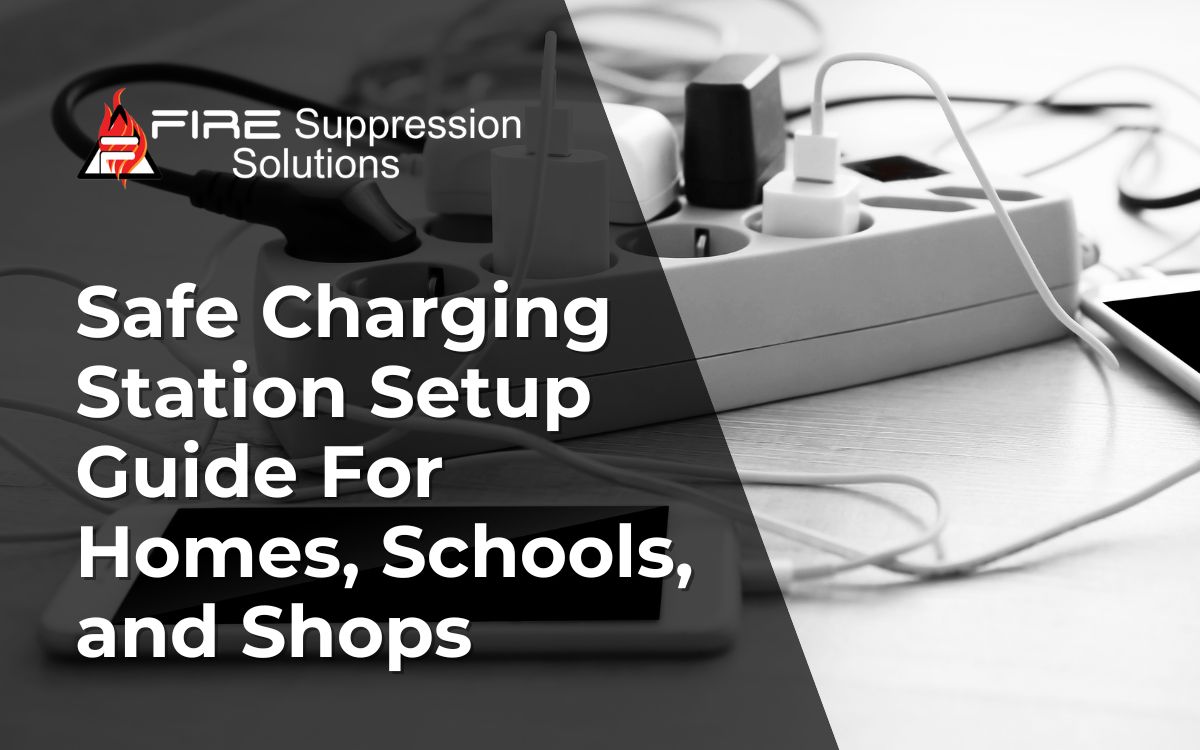A lot of lithium-ion trouble starts long before smoke. It starts at the charging spot—on a bed instead of a table, in a daisy-chain of adapters, or with a look-alike charger that runs hot. The good news: safer setups are simple, repeatable, and look the same at home, in classrooms, and on counters.
What a Safe Charging Spot Actually Is
Think cooling and clearance. Devices need a hard, flat, uncovered surface so heat can dissipate, a listed charger that matches the device, and cord management that keeps exits clear. That’s the foundation everywhere.
Home: Make the Safe Place the Default
Choose a small table or countertop away from pillows, blankets, and curtains. Plug into a power strip (UL/ETL mark) with no other adapters piggy-backed on it. Keep cords short and routed low so nobody yanks a device off the edge. Build a routine: charge during waking hours, unplug when full, and never leave devices to charge under bedding.
Common home mistakes to ditch:
- Charging on beds, sofas, carpets, or stacks of paper
- Resting devices on blankets/towels (it traps heat)
- Using bargain, unverified chargers because they “fit”
- Leaving cords across walk paths or doorways
School and Library: Make it Obvious
Charging should happen at tables or dedicated stations, not in aisles, doorways or window ledges. Label the right charger for each cart or device set, unplug when full, and secure carts overnight.
A tiny rules sign at eye level —“Table • Tidy cords • Unplug”— keeps everyone on the same page without a lecture.
Cart and station quick wins:
- Route cords in channels or along walls; tape is not a cord-management strategy
- One UL listed strip per outlet; no daisy-chains
- Keep charging areas out of egress paths; doorways stay clear
- Replace strips that feel warm, look scorched, or have loose sockets
Shops, counters, and service bays: fight the “temporary” setup
“Temporary” becomes permanent. Get rid of multiple adapters and under-desk spaghetti. Use a single UL listed power strip per receptacle, space devices so they don’t heat each other, and keep charging away from combustibles and out of egress paths. Assign the proper charger to each device.
Red flags in workplaces:
- Power strips plugged into other power strips
- Chargers dangling in front of a door, curtain or stairwell
- “Universal” bricks running hot because they’re mismatched
- Extension cords that live under rugs
How to choose a power strip (and when to replace it)
Look for a recognized testing mark (UL/ETL), a resettable breaker, and a housing that isn’t brittle or discolored. If a plug wiggles, the socket feels loose, or the strip gets warm under light load, replace it. One strip per outlet—no exceptions.
Ten-minute upgrade (any setting)
- Pick one table surface and declare it the charging spot.
- Verify the listed charger for each device; remove look-alikes.
- Swap in a UL listed power strip; eliminate all daisy-chains.
- Route cords low and tidy; keep doorways clear.
- Add a simple routine: charge while awake, unplug when full.
If anything seems off—heat, chemical odor, swelling, hissing, smoke—stop.
Hands off • Close the door • Evacuate • Call 911. Do not carry a smoking device outside. Cooling and isolation come first.
Why this matters
Lithium-ion battery fires are not ordinary fires; they’re driven by a self-heating chemical chain reaction and can re-ignite if cells stay hot. Good charging spots reduce stress on packs, reduce heat build-up, and keep exits open—so if something does go wrong, people can move away quickly and responders can work without fighting clutter.
Keep everyone aligned
We’ve turned these rules into simple, shareable resources for homes, classrooms, and workplaces. Visit our Fire Prevention Week Resource Hub (free downloads) for concise charging rules, incident steps, and everyday checklists that reinforce the same habits everywhere: buy smart, charge smart, recycle right.
Safety note: Always follow manufacturer instructions, local policy, and on-scene directions from first responders.
Reviewed by the Fire Suppression Solutions Technical Team.

